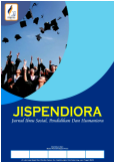The Implementation of Inclusive Education at SDN 30 Palembang : Challenges and Supports
DOI:
https://doi.org/10.56910/jispendiora.v4i2.2261Keywords:
Challenges, Inclusive Education, Support Systems, SupportAbstract
This study aims to describe the implementation of inclusive education at State Elementary School (SDN) 30 Palembang, focusing on the challenges and forms of support faced in its implementation. Inclusive education is an approach that ensures all children, including children with special needs (ABK), get equal access to education in a friendly and open environment. The research method used is descriptive qualitative, the results of the study indicate that the main challenges in the implementation of inclusive education at SDN 30 Palembang were the lack of disability-friendly facilities, as well as the ongoing stigma from the community towards ABK students. Other technical obstacles are the limited ratio of ABK per class set by government policy and the lack of supporting resources. However, this study also found significant support, such as teacher training, principal involvement, and cooperation with external institutions that encourage the sustainability of inclusive education. This study concludes that the implementation of inclusive education at SDN 30 Palembang shows positive developments even though it still faces structural and social challenges. Policy strengthening, teacher capacity building, and community support are needed so that the inclusive education system can run more optimally and sustainably.
References
Ainscow, M., & Miles, S. (2008). Making education for all inclusive: Where next? Prospects, 38(1), 15–34. https://doi.org/10.1007/s11125-008-9055-0
Booth, T., & Ainscow, M. (2011). The index for inclusion: Developing learning and participation in schools. Centre for Studies on Inclusive Education.
Forlin, C. (2010). Teacher education for inclusion: Changing paradigms and innovative approaches. Routledge.
Harrower, J. K., & Dunlap, G. (2001). Including children with autism in general education classrooms: A review of effective strategies. Behavior Modification, 25(5), 762–784. https://doi.org/10.1177/0145445501255006
Irwanto, Lusli, M., & Yuliani, R. (2010). Kebijakan dan layanan pendidikan inklusif di Indonesia. Depdiknas dan UNICEF.
Kementerian Pendidikan Nasional. (2009). Peraturan Menteri Pendidikan Nasional Nomor 70 Tahun 2009 tentang pendidikan inklusif bagi peserta didik yang memiliki kelainan dan memiliki potensi kecerdasan dan/atau bakat istimewa.
Loreman, T., Deppeler, J., & Harvey, D. (2010). Inclusive education: Supporting diversity in the classroom. Routledge.
Slee, R. (2011). The irregular school: Exclusion, schooling and inclusive education. Routledge.
Sunardi, Yusuf, M., Gunarhadi, Priyono, & Yeager, J. L. (2011). The implementation of inclusive education for students with special needs in Indonesia. Excellence in Higher Education, 2(1), 1–10. https://doi.org/10.5195/ehe.2011.27
Undang-Undang Republik Indonesia. (2003). Undang-Undang Nomor 20 Tahun 2003 tentang Sistem Pendidikan Nasional.
Undang-Undang Republik Indonesia. (2011). Undang-Undang Nomor 19 Tahun 2011 tentang Pengesahan Konvensi Hak-Hak Penyandang Disabilitas.
UNESCO. (2009). Policy guidelines on inclusion in education. UNESCO.
UNESCO. (2017). A guide for ensuring inclusion and equity in education. UNESCO Publishing.
UNESCO. (2020). Global education monitoring report 2020: Inclusion and education – All means all. UNESCO Publishing.
Downloads
Published
How to Cite
Issue
Section
License
Copyright (c) 2025 JISPENDIORA Jurnal Ilmu Sosial Pendidikan Dan Humaniora

This work is licensed under a Creative Commons Attribution-ShareAlike 4.0 International License.








